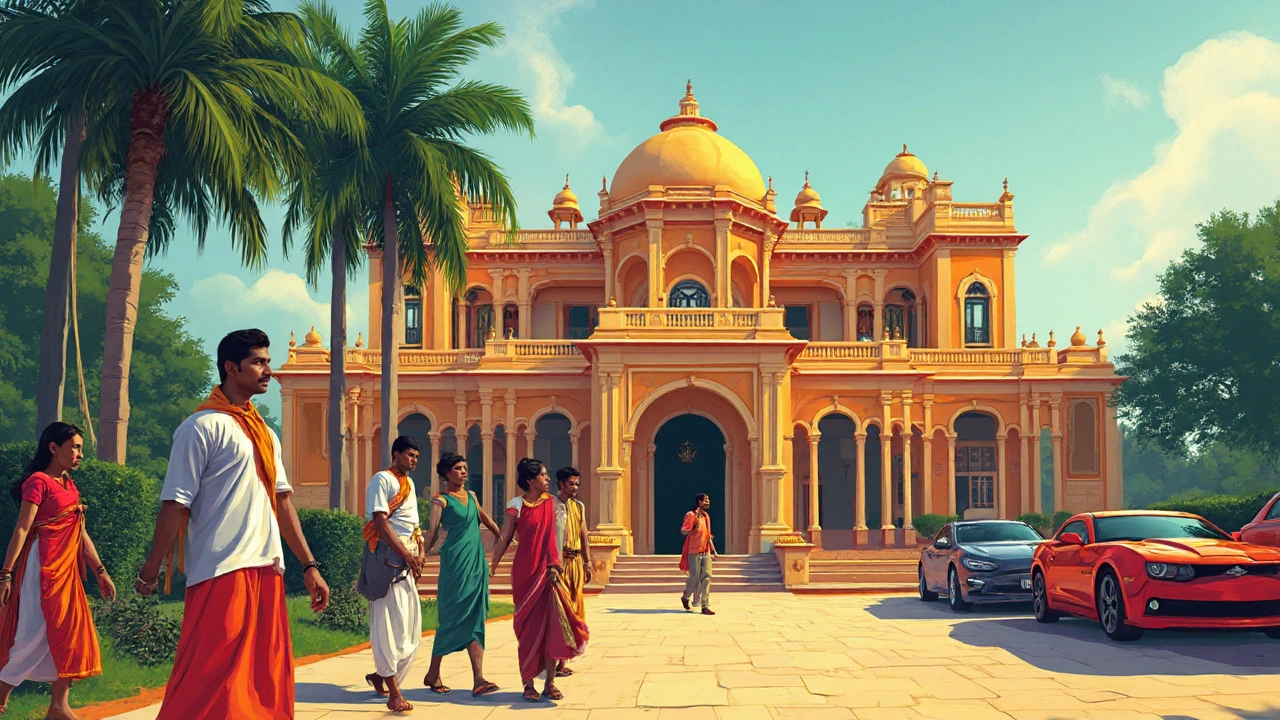If you heard someone at a café in Mumbai say, "I want to be a billionaire," how would you react? Some people laugh. Others imagine private jets, huge houses, and Instagram-worthy vacations. Yet when you ask, "How much money is needed to be a billionaire in India?"—most don't have an exact answer. The term "billionaire" feels mysterious, powerful, maybe even out of reach. But there are some hard numbers hiding under all the glitz. Let’s dig deep and discover what it really takes to join India’s billionaire club.
What Does 'Billionaire' Really Mean in India?
First things first: the word billionaire carries different weight depending on which country you are in. In the US, a billionaire has at least one billion dollars. But in India, do you measure your billions in US dollars or Indian rupees? That difference changes the story fast.
In Indian financial news, the term "billionaire" almost always means a net worth of at least $1 billion USD. For today, let’s talk about dollars, not rupees. If you want the Indian rupee figure, just multiply the US dollar amount by the currency rate. As of August 2025, the exchange rate sits at about 84 rupees for 1 USD.
So, in Indian rupees, a billionaire in the global sense is someone with about 8,400 crore rupees (1 crore = 10 million; so, 8,400 x 10,000,000 = 84,000,000,000 rupees). That’s 8,400,000,0000—or 84 billion rupees.
But is being called a "billionaire" the same as having a billion in cash, ready to spend? Not really. Most Indian billionaires own companies, land, stocks, and sometimes mansions or yachts. Only a small part is actually cash in the bank. It’s net worth—the value of everything they own, minus everything they owe.
Let’s put this into real numbers. Here’s a quick look at some of India’s wealthiest people and their net worth (as reported in early 2025):
| Name | Estimated Net Worth (USD) | Estimated Net Worth (INR) |
|---|---|---|
| Mukesh Ambani | $110 billion | ₹9.24 lakh crore |
| Gautam Adani | $78 billion | ₹6.55 lakh crore |
| Shiv Nadar | $34 billion | ₹2.83 lakh crore |
| Savitri Jindal | $27 billion | ₹2.27 lakh crore |
| Kumar Mangalam Birla | $19 billion | ₹1.59 lakh crore |
Those numbers prove the point: a true Indian billionaire by global standards holds wealth north of $1 billion—so roughly ₹8,400 crore. Local media sometimes call people with ₹1,000 crore or more "billionaires" in rupee terms, but internationally, the title needs that sweet billion USD.
Are there a lot of billionaires in India? The number is rising. According to the Forbes Billionaires List 2025, India has 190 dollar billionaires, up from 169 in 2022. That’s the world’s third largest billionaire group, behind only the US and China. The bar is high, but more Indians are breaking through every year.
And what do these billionaires own? It’s usually not just money stacked in vaults. They have shares in big companies—Reliance, Adani Group, HCL, massive real estate, pharma, and tech businesses. Their value jumps or dips with the stock market.
So, “becoming a billionaire” in India means having a billion dollars’ worth of assets after clearing all your debts. It’s more about what you control and own rather than the cash you could withdraw tomorrow.

The Pathways to Billionaire Status: How Have Indians Built Their Fortunes?
Let’s be honest: nobody wakes up to a phone call saying, “Congrats, you’re a billionaire!” Each journey is full of twists, family dramas, wild risks, and the occasional lucky break. But if you break down the numbers, certain trends and patterns pop up for India's richest folks.
Family Wealth: Some billionaires were born into business families. Mukesh Ambani’s father, Dhirubhai, built Reliance from scratch. Still, Mukesh took on insane projects—the world’s largest oil refinery, a game-changing telecom network, mega real estate. Inheritance gave a head start, but huge bets grew the wealth.
First Generation Self-Starters: Here’s the cool part. Many Indian billionaires started from modest places. Take Gautam Adani, who didn’t finish college and worked as a diamond sorter before building a multi-sector empire. Uday Kotak began as a small finance player and grew into a banking giant. Let’s not forget Byju Raveendran, the former math teacher who made edtech cool across the nation.
Tech, Pharma, Retail, and Manufacturing Powerhouses: Where is the big money right now? The tech sector’s boom pushed names like Shiv Nadar and Azim Premji to the top. Pharmaceuticals catapulted Dilip Shanghvi (Sun Pharma) and Cyrus Poonawalla (Serum Institute) up the ranks—especially in the vaccination era. Fast-growing retail is behind Radhakishan Damani of DMart fame.
Real Estate and Infrastructure: Mumbai’s skyline wasn’t built by chance. Riches are made in real estate. Engineering and energy are pure gold for those ready to take on India’s gigantic infrastructure challenges.
So, what’s the secret recipe? It's a mix of taking crazy-smart risks, spotting industry shifts before everyone else, and scaling bigger than your wildest dreams. Of course, building the right team, grabbing the right moment, and sometimes even surviving political and regulatory storms play a role.
Not everyone built their empires legally or ethically—those tales are for a different list. But one thing stands out: nearly every Indian billionaire’s path is bumpy, crowded with challenges, and loaded with late nights and tough calls. Instant success? Doesn’t exist. Most took decades to reach the magic billion mark.
If you’re saving money in a bank hoping to reach a billion someday—well, just doing the math shows it’s not happening. You need outsized returns or business growth, not just plain old savings or fixed deposits. A bank FD gives you 6-8% interest, but the richest Indians often see investments double at a much faster pace through bold business bets or booming share prices.
But what about taxes? New billionaires have an army of tax advisors. India’s inheritance laws are more relaxed than the West—no estate tax for direct transfers—but be ready for GST, corporate tax, wealth tax (if it’s ever reintroduced), and even scrutiny from the Enforcement Directorate if something smells fishy.
| Pathway | Example | Key Industry |
|---|---|---|
| Family Inheritance & Expansion | Mukesh Ambani | Oil, Telco, Retail |
| First-Gen Entrepreneur | Gautam Adani | Ports, Logistics, Energy |
| Tech/Startup Boom | Byju Raveendran | EdTech |
| Pharma Surge | Dilip Shanghvi | Pharmaceuticals |
| Retail Giant | Radhakishan Damani | Retail/Real Estate |
One thing nobody tells you: hitting a billion once doesn’t mean you stay a billionaire forever. Stock price crashes, economic policy shifts, scandals—wealth can drop fast. Just ask anyone who held Yes Bank shares in 2018 or tracked the Adani Group’s wild swings after short-selling attacks.
Bottom line: to get there, you’ll need ambition, a real stomach for risk, relentless drive, and a portfolio that can ride out India’s unpredictable economy. Sure, luck helps—but it’s not the whole story.

Pro Tips and Surprising Facts: Inside the Indian Billionaire Lifestyle
All this talk about crores and billions can feel abstract. So what do Indian billionaires actually do with all that money? And how do they keep growing it?
- Billionaire in India doesn’t always mean flashy spending. Mukesh Ambani’s house “Antilia” cost over $2 billion, making it the priciest in the country—but plenty of billionaires keep a low profile, living in solid but not showy homes.
- Giving it away is on the rise. Indian billionaires donated over ₹8,450 crore in 2024, according to the EdelGive Hurun India Philanthropy List. Shiv Nadar topped the charts. More young billionaires are setting up foundations and scholarships instead of just stashing wealth.
- India now has “unicorn billionaires.” Techies like Bhavish Aggarwal (Ola) and Nikhil Kamath (Zerodha) made their billions entirely online—no factories, no warehouses, just code, hustle, and smart moves.
- Private jets, supercars, artwork, and rare watches? Sure, some go all-in on luxury. But most invest in companies, stocks, land, or start-ups—the goal is to turn a billion into two. Old money often prefers classic jewelry and art, new money is into Silicon Valley investments and global real estate.
- Unlike in the West, India doesn’t currently have an inheritance tax. Passing down billions is easier, but growing the pie for future generations gets complicated with family splits and succession battles (Google the Ambani family split drama for a real-life soap opera).
- Government influence is everywhere. Regulatory changes, court cases, or policy flips can make or break fortunes, so billionaires have teams just to handle legal, lobbying, and public relations work.
Want to join the billionaire club? The first step is dreaming bigger than you think is possible. Second, pick a fast-growing industry: tech, renewable energy, finance, or pharma still lead the pack. Third, build a team you can trust—no billionaire ever did it alone. And finally, if you ever do reach that $1 billion mark, get ready for constant requests: family investments, charity dinners, even more selfies than a Bollywood star.
Here’s a lesser-known fact: in dollar terms, India’s poorest billionaire is still richer than 99.999% of all Indians. Yet they often battle for a spot near the bottom of the Forbes list. Among themselves, there’s crazy competition—each new IPO, merger, or product can shake up the pecking order overnight.
If you want numbers, not just dreams, remember this: with $1 billion, you could buy a new Rolls Royce every single day for ten years and still not run out of money—assuming you never pay road tax.
| Luxury Item | Approximate Price (INR) | How Many With ₹8,400 crore? |
|---|---|---|
| Rolls Royce Phantom | ₹10 crore | 840 |
| Private Jet (Embraer Legacy 650) | ₹180 crore | 46 |
| Midtown Mumbai Apartment | ₹25 crore | 336 |
| Named Scholarship Fund | ₹2 crore | 4,200 |
The truth: there's no shortcut to billionaire status. You need to eat, sleep, and breathe the bigger picture—build, invest, grow. Billionaires don’t just count money; they create empires, solve big problems, and (if they’re smart) leave the world a bit better than they found it. The entry ticket? Right now, about $1 billion, or ₹8,400 crore net worth—with a nerve for risk, a love for numbers, and the will to play the long game.

